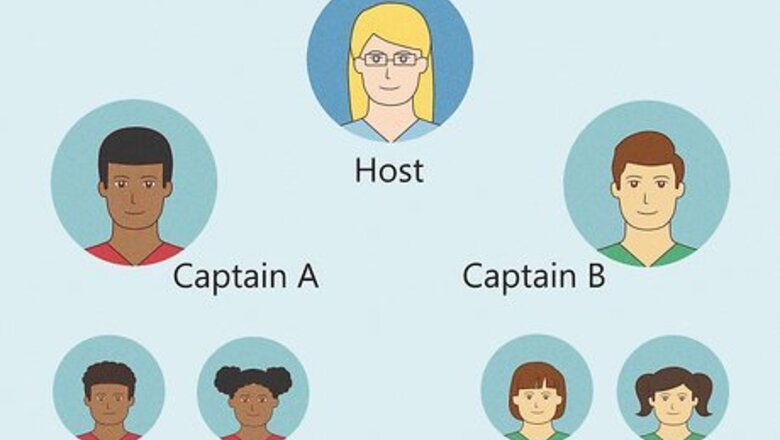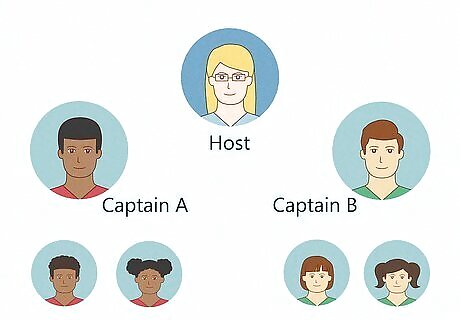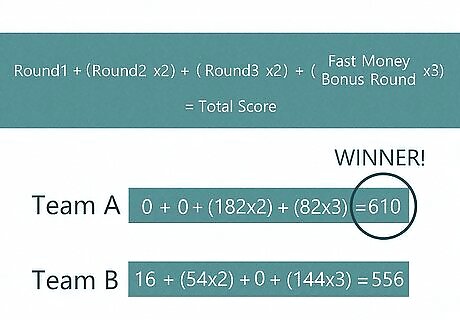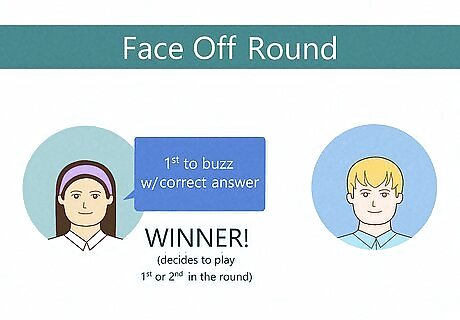
views
Disclaimer: The specific rules and gameplay may differ depending on the exact version of the Family Feud party game that you’re playing. However, the basic rules listed below should still apply.
Family Feud Party Game Rules

Setup Choose one player to be the host and divide everyone else into 2 even teams. Then, pick a person to serve as the “captain” of each team. If only 3 total people are playing, choose 1 to be the host and have the other 2 play on separate teams. All versions of the Family Feud party game typically come with Face Off and Fast Money cards, which provide premade prompts/questions and survey answers for the host to reference throughout the game. Many games also come with special Face Off and Fast Money Answer Pads, which allow the host to track scores, strikes, and the correct answers provided (and their point values).

Face Off Round A player from each team plays in the Face Off round, where the host asks a question from one of the Face Off cards. The first player to raise their hand gets to share an answer—if it’s the top answer from the round, that team gets to decide if they play first in the round (or if they go second and pass to the other team). If it’s not the top answer (or if it’s incorrect), the player from the other team gets to submit an answer. If this answer ranks higher on the board, that team gets to decide if they pass or play. Any correct answers are written on the Face Off Answer Pad provided with your game, along with the corresponding number of points. If the second team gets a wrong answer (or chooses a lower-ranking answer), a new set of players get to guess, offering answers in the same order as the previous pair of players. At this point, whichever team has submitted the highest-ranking answer gets to choose if they play first or second. Alternative: If both the first and second players guess incorrectly, let the first team who “buzzed in” decide if they want to play themselves or pass gameplay on to the other team. Throughout the game, players need to offer an answer as soon as possible. If they don’t, play automatically switches to the opposite team.

Round 1 The designated team continues gameplay, and the host specifies how many total answers are on the board. Another player offers an answer to the same question from the Face Off Round—if it’s correct, it’s marked on the Face Off Answer Pad with the corresponding point total; if it’s incorrect, a “strike” is marked on one of the strike boxes provided on the same Pad. Continue cycling through the players and collecting new answers until either all the correct answers are listed or the team gets 3 strikes. If all correct answers are guessed: Add up all the points and give them to designated team. Then, move on to Round 2. If the first team gets 3 strikes: The opposing team gets a chance to guess. Each opposing team member offers a guess, with the team captain choosing the best one to submit. If the answer is correct/on the board, they steal all the points for Round 1. In any given round, the host can decide on the time limit players have to provide an answer (like 10 seconds).

Round 2 Complete a second Face Off round with a new player from each team, with the host reading a new question. Like before, the winning team gets to decide if they play the round or if they “pass” play to the other team. The host announces how many total answers there are, and the controlling team continues to guess answers to the same question. The host marks down the correct answers and their corresponding point totals on a new sheet of the Face Off Pad. This round, though, the host doubles the point values as they write them down. Gameplay continues until the controlling team guesses all the answers or amasses 3 strikes. If all correct answers are guessed: The doubled point totals are combined and added to the corresponding team’s total score (including their Round 1 points, if applicable). If the first team gets 3 strikes: Like before, the opposing team gets a chance to guess one of the remaining answers on the board. If guessed correctly, they steal all the points. If their guess is incorrect, the original team gets to keep the points.

Round 3 A new set of players compete in another Face Off Round, where the host asks yet another new question. The winning team chooses to pass or play, the host reveals the total number of answers on the board, and the controlling team continues to guess the remaining survey answers. The host writes down any correct answers on yet another sheet on the Face Off Pad, doubling all the point totals as they go. Round 3 keeps going until the playing team reaches 3 strikes or successfully guesses all the right answers. If all correct answers are guessed: Add the doubled point totals to the winning team’s total score, including the totals from previous rounds. If the first team gets 3 strikes: Give the opposing team a chance to guess one of the leftover answers on the board. If their guess lands on the board, they get all of the Round 3 points instead.

Fast Money Bonus Round Each team captain nominates a player to participate in the Fast Money—the team with the higher point total gets to go first. Then, the host reads a series of 5 quick questions, giving the player a chance to answer after each one. The player has a limited amount of time to submit a single guess for each answer; if the answer isn’t listed on the survey, the host gives them one more chance to guess correctly before moving on to the next question. Once the first player is finished, the player from the other team gets to go, repeating the same gameplay process as the first person. If they guess any of the same answers as the first player, however, they have to guess again. Players can’t receive any aid from their teammates during this round. It might help to have the second player wait in another room while the first player guesses. The host gets to decide how long the Fast Money Bonus Round lasts, and how much time each player has to guess in total. Ask another person/player to write down the provided answers on the Fast Money Pad so the host can focus completely on the round.

Winning the Game The host triples the point totals from the Fast Money Bonus Round and adds them to the existing point totals. Whichever team has the highest point total wins Family Feud!
Classroom Family Feud Rules

Setup Split the class into two separate groups (or “teams”)—try to make these teams as even as possible. The teacher acts as the host for the game. For classroom Family Feud, you’ll need to come up with questions and answers that are related to the material that you’re reviewing. It helps to have a PowerPoint that’s preloaded with the corresponding answers. Here’s a free template to help you get started. For a history review, you might have a question like “Which countries were part of the Allies in WW1?” and have a list of answers like the USA, Great Britain, France, Russia, Japan, and Italy that the students can guess. It helps to come up with questions that have multiple correct answers to guess from, similar to a true Family Feud question.

Face Off Round Invite a player from each team to approach the center of the gameplay area. Read the question to both players—whoever “buzzes in” with a correct answer gets to choose if their team plays first or passes play to the opposing team. “Buzzing in” can be as simple as students raising their hands. Choose a system that makes sense for you and your classroom!

Gameplay Rounds The controlling team continues to try and guess the correct answers, collecting points as they go. If they guess incorrectly, they receive a strike. Once they get 3 strikes, the opposing team gets a chance to guess the remaining answers. At the end of each round, give each team points corresponding to the questions they answered correctly. Have all the students go/submit answers in a specific order, like actual Family Feud. If you’re playing in a physical classroom, invite the students to walk to the center of the gameplay space for the Face Off Round. You can also allot points in a more traditional Family Feud style, where the opposing team gets the chance to steal all of the round’s points by guessing correctly. Classroom Family Feud doesn’t typically have a “Fast Money” round.

Ending the Game Continue playing the game, going through however many rounds/questions of content you have for the review. Whichever team collects the most points throughout the game is declared the winner.



















Comments
0 comment